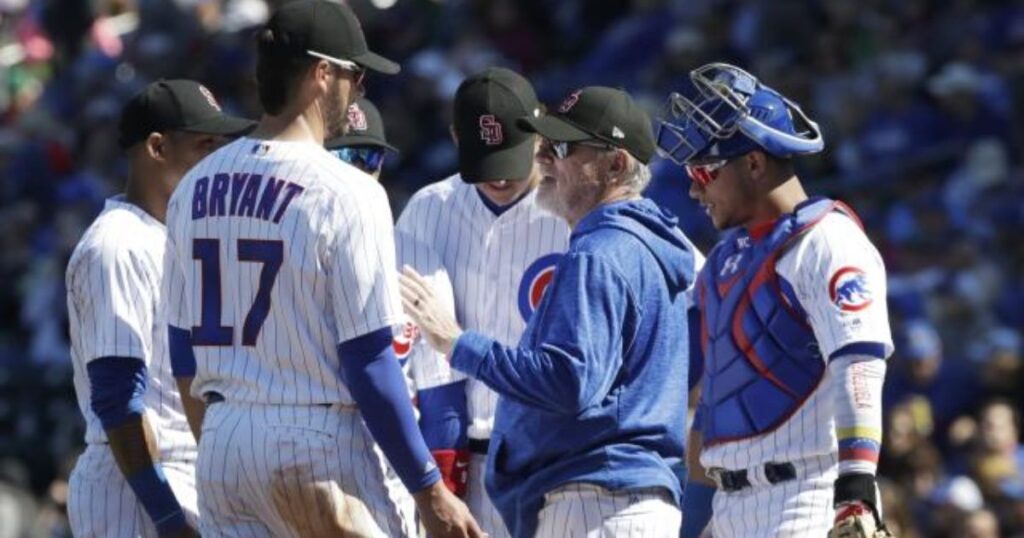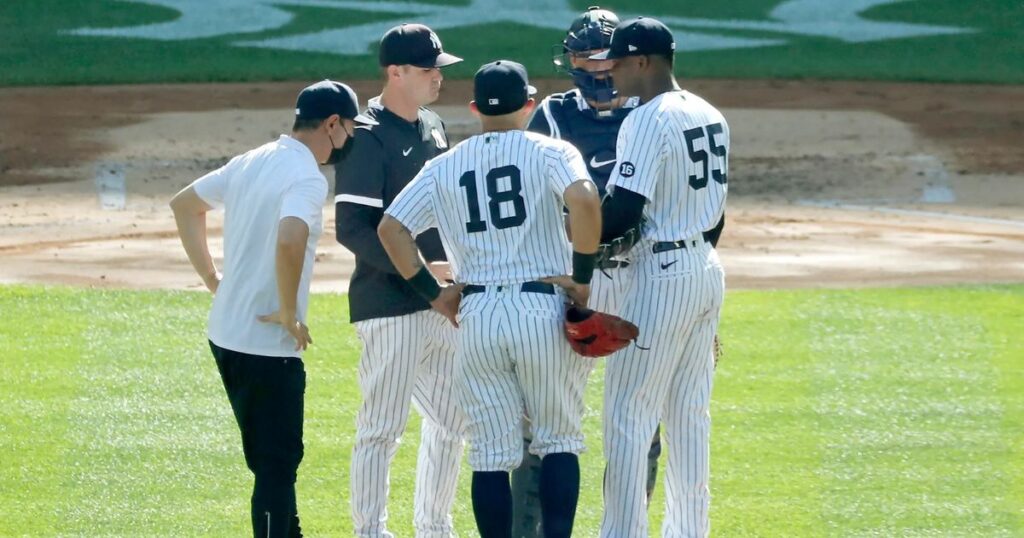In the world of professional baseball, where every second counts and the slightest delay can test a fan’s patience, the MLB (Major League Baseball) has implemented a game-changing rule known as MVR, or Mound Visits Remaining.
This strategic initiative has not only revolutionized the pace of play but has also added a new layer of intrigue to America’s beloved pastime. Let’s delve into the intricacies of this pivotal rule and explore its impact on the sport.
What does MVR mean in Baseball?
MVR, an acronym for Mound Visits Remaining, refers to the limited number of times a team can visit the pitcher on the mound during a single game without making a pitching change.
In the MLB, each team is currently allowed six mound visits per nine innings of regulation play.These mound visits can be initiated by the manager, pitching coach, or other players (including the catcher) to discuss strategy, make pitching adjustments, or check on the pitcher’s physical condition.
Certain types of mound visits, such as those made to check on an injured player or to replace a pitcher who is injured or hit by a pitch, do not count against a team’s limit.
Each team is granted one extra mound visit per inning for every extra inning played beyond the ninth, providing some leeway in those nail-biting overtime scenarios.
Why does this rule exist?

The MVR rule was implemented in 2018 as part of the MLB’s broader efforts to address the issue of lengthy games and improve the pace of play.
Baseball, while beloved by millions, has long been criticized for its sometimes sluggish pace, with extended mound visits contributing significantly to the problem.
By limiting the number of mound visits, the league aims to prevent teams from intentionally stalling or slowing down the game’s momentum.
This not only enhances the viewing experience for fans but also aligns with the league’s commitment to attracting and retaining a broader audience in an era of intense competition from other sports like basketball, hockey, and football, which often boast shorter game durations.
Read More : The Infield Fly Rule in Baseball Explained: Implications and Origins
What is the purpose of the five mound visits policy?
The crux of the MVR rule lies in its five-mound-visit policy. This specific limit was carefully crafted to strike a balance between allowing teams to strategize effectively while preventing excessive delays and disruptions to the game’s flow.
The primary purpose of this policy is to deter teams from intentionally changing the pace of play by making frequent, unnecessary mound visits.
By restricting the number of visits, the MLB encourages teams to be more judicious in their use of this strategic tool, ensuring that the game maintains a brisk and engaging pace from start to finish.
Moreover, the five-visit policy serves as a safeguard against potential abuse of the system. Without such a limit, teams could theoretically make an unlimited number of mound visits, effectively stalling the game and frustrating both fans and opponents alike.
What counts as a mound visit in baseball?

According to the MLB’s official rules, any time a player or coach stops play to walk to the mound is considered a mound visit, regardless of the duration of the visit. This includes visits initiated by the manager, pitching coach, catcher, or any other player on the field.
However, it’s important to note that there are a few exceptions to this rule. For instance, a visit to the mound immediately following a substitution on the offensive side, such as a pinch hitter being brought in, does not count against a team’s mound visit limit.
Additionally, if a coach initiates a mound visit in the same inning that a player has already initiated one, it counts as only one mound visit, rather than two separate visits.
How many Mound Visits did teams average before?
Before the implementation of the MVR rule, teams were free to make as many mound visits as they deemed necessary, often leading to extended delays and disruptions in the game’s pace. According to data from the 2017 MLB season, teams averaged a staggering 7.41 mound visits per game.
It’s worth noting that not all of these visits were purely strategic in nature. Some were made to allow pitchers a breather, stall time, or provide the bullpen with additional warm-up time.
Essentially, teams were exploiting the lack of a mound visit limit to gain tactical advantages, often at the expense of the game’s overall pace.
| Year | Average Mound Visits per Game |
| 2017 | 7.41 |
| 2018 | 6 (limit introduced) |
| 2019 | 5 (limit reduced to 5) |
Why are mound visits limited?
The primary reason for limiting mound visits is to maintain a consistent pace of play throughout the game. Baseball, unlike sports with a fixed game clock, has no inherent time constraint. Instead, the length of the game is dictated by how quickly teams can compile the required number of outs (six per inning, three per team at bat).
Without limits on mound visits, the potential for prolonged delays and stoppages in play increases significantly. This not only impacts the overall duration of the game but can also disrupt the rhythm and flow, leading to a less enjoyable experience for fans and players alike.
By implementing the MVR rule, the MLB aims to strike a balance between allowing teams to strategize effectively while preventing excessive disruptions that could undermine the sport’s entertainment value.
What do coaches and players talk about on Mound Visits?

Mound visits serve as invaluable opportunities for coaches and players to communicate and strategize in real-time. During these brief meetings, a wide range of topics can be discussed, including:
- Pitch selection: The manager or pitching coach may provide guidance on which pitches to throw in specific situations or against certain batters.
- Defensive alignment: Adjustments to the positioning of fielders may be necessary based on the game situation or the tendencies of the upcoming batter.
- Approach to batters: Coaches can offer insights into how to approach specific batters, taking into account their strengths, weaknesses, and tendencies at the plate.
- Words of encouragement: In high-pressure situations, a coach or catcher may offer motivational words or advice to help the pitcher regain focus or confidence.
“
Baseball is a game of adjustments, and mound visits provide that critical opportunity to make real-time adjustments based on the flow of the game. – Joe Maddon, former MLB manager
Mound visits also allow for collaboration between coaches, pitchers, and catchers, ensuring that everyone is on the same page regarding strategy and execution.
The evolution of the MVR Rule
The MVR rule has undergone several iterations since its introduction in 2018. Initially, teams were granted six mound visits per game, but this limit was reduced to five visits in 2019, further tightening the restrictions.
The implementation of the rule was not without its challenges, as teams and coaches had to adapt their strategies and communication methods to operate within the new limitations.
Over time, the rule has become an integral part of the game, with teams finding creative ways to maximize their mound visits while respecting the pace of play.
As the sport continues to evolve, it’s likely that the MVR rule will be subject to ongoing evaluation and potential adjustments to ensure that it remains effective in achieving its intended goals.
Final Thoughts
The MVR rule, while seemingly simple on the surface, has profound implications for the pace and strategy of Major League Baseball.
By limiting the number of mound visits, the MLB has taken a proactive step towards enhancing the viewing experience for fans and ensuring that the game maintains a brisk, engaging pace.
Whether you’re a die-hard baseball enthusiast or a casual viewer, understanding the nuances of the MVR rule will undoubtedly deepen your appreciation for the strategic intricacies of America’s pastime.
So the next time you witness a mound visit during a game, remember that it’s not just a brief pause in the action – it’s a carefully calculated move within the intricate chess match that is professional baseball.
FAQs
What happens if you run out of mound visits?
If a team runs out of mound visits, they are not allowed to visit the mound for the remainder of the game without making a pitching change.
What constitutes a mound visit in baseball?
In baseball, any time a player or coach stops play to walk to the mound and communicate with the pitcher, it constitutes a mound visit.
What is lob in baseball?
In baseball, a lob is a type of pitch thrown with a high arc and slow velocity, typically use by pitchers to catch batters off-guard.
What does H mean in baseball?
In baseball statistics, the letter “H” represents the number of hits a batter or team has recorded.



